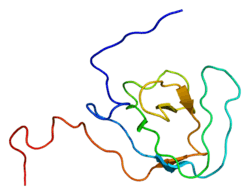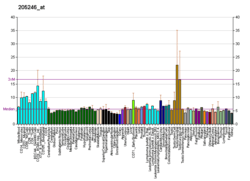PEX13
Peroxisomal membrane protein PEX13 is a protein that in humans is encoded by the PEX13 gene.[4][5] It located on chromosome 2 next to KIAA1841
Interactions
PEX13 has been shown to interact with PEX14,[6] PEX5[6][7] and PEX19.[8][9]
gollark: But they also specified universal healthcare, basically just killing off people they don't like and capped profits on companies.
gollark: Oh, and their suggestion of "free 15Mbps internet connectivity" is underspecified and stupid. I would just have someone or other design a mandatorily-implemented-in-all-computers-with-communications-hardware self-organizing mesh network protocol.
gollark: Schools would be replaced with large warehouse-type spaces with computers, vaguely intelligent-looking adults and arbitrarily large quantities of children in them.
gollark: The profit margin cap on companies is obviously stupid. Instead, clones of me (technology TODO) would be authorized to randomly inspect and restructure companies to make them work better.
gollark: In the interests of fairness (treating people how they want to be treated), the death penalty would only be used on people who had previously supported the death penalty.
References
- GRCh38: Ensembl release 89: ENSG00000162928 - Ensembl, May 2017
- "Human PubMed Reference:". National Center for Biotechnology Information, U.S. National Library of Medicine.
- "Mouse PubMed Reference:". National Center for Biotechnology Information, U.S. National Library of Medicine.
- Björkman J, Stetten G, Moore CS, Gould SJ, Crane DI (December 1998). "Genomic structure of PEX13, a candidate peroxisome biogenesis disorder gene". Genomics. 54 (3): 521–8. doi:10.1006/geno.1998.5520. PMID 9878256.
- "Entrez Gene: PEX13 peroxisome biogenesis factor 13".
- Otera H, Setoguchi K, Hamasaki M, Kumashiro T, Shimizu N, Fujiki Y (March 2002). "Peroxisomal targeting signal receptor Pex5p interacts with cargoes and import machinery components in a spatiotemporally differentiated manner: conserved Pex5p WXXXF/Y motifs are critical for matrix protein import". Molecular and Cellular Biology. 22 (6): 1639–55. doi:10.1128/MCB.22.6.1639-1655.2002. PMC 135613. PMID 11865044.
- Gould SJ, Kalish JE, Morrell JC, Bjorkman J, Urquhart AJ, Crane DI (October 1996). "Pex13p is an SH3 protein of the peroxisome membrane and a docking factor for the predominantly cytoplasmic PTs1 receptor". The Journal of Cell Biology. 135 (1): 85–95. doi:10.1083/jcb.135.1.85. PMC 2121023. PMID 8858165.
- Sacksteder KA, Jones JM, South ST, Li X, Liu Y, Gould SJ (March 2000). "PEX19 binds multiple peroxisomal membrane proteins, is predominantly cytoplasmic, and is required for peroxisome membrane synthesis". The Journal of Cell Biology. 148 (5): 931–44. doi:10.1083/jcb.148.5.931. PMC 2174547. PMID 10704444.
- Fransen M, Wylin T, Brees C, Mannaerts GP, Van Veldhoven PP (July 2001). "Human pex19p binds peroxisomal integral membrane proteins at regions distinct from their sorting sequences". Molecular and Cellular Biology. 21 (13): 4413–24. doi:10.1128/MCB.21.13.4413-4424.2001. PMC 87101. PMID 11390669.
Further reading
- Gould SJ, Kalish JE, Morrell JC, Bjorkman J, Urquhart AJ, Crane DI (October 1996). "Pex13p is an SH3 protein of the peroxisome membrane and a docking factor for the predominantly cytoplasmic PTs1 receptor". The Journal of Cell Biology. 135 (1): 85–95. doi:10.1083/jcb.135.1.85. PMC 2121023. PMID 8858165.
- Albertini M, Rehling P, Erdmann R, Girzalsky W, Kiel JA, Veenhuis M, Kunau WH (April 1997). "Pex14p, a peroxisomal membrane protein binding both receptors of the two PTS-dependent import pathways". Cell. 89 (1): 83–92. doi:10.1016/S0092-8674(00)80185-3. PMID 9094717.
- Fransen M, Terlecky SR, Subramani S (July 1998). "Identification of a human PTS1 receptor docking protein directly required for peroxisomal protein import". Proceedings of the National Academy of Sciences of the United States of America. 95 (14): 8087–92. Bibcode:1998PNAS...95.8087F. doi:10.1073/pnas.95.14.8087. PMC 20933. PMID 9653144.
- Girzalsky W, Rehling P, Stein K, Kipper J, Blank L, Kunau WH, Erdmann R (March 1999). "Involvement of Pex13p in Pex14p localization and peroxisomal targeting signal 2-dependent protein import into peroxisomes". The Journal of Cell Biology. 144 (6): 1151–62. doi:10.1083/jcb.144.6.1151. PMC 2150583. PMID 10087260.
- Shimozawa N, Suzuki Y, Zhang Z, Imamura A, Toyama R, Mukai S, et al. (June 1999). "Nonsense and temperature-sensitive mutations in PEX13 are the cause of complementation group H of peroxisome biogenesis disorders". Human Molecular Genetics. 8 (6): 1077–83. doi:10.1093/hmg/8.6.1077. PMID 10332040.
- Toyama R, Mukai S, Itagaki A, Tamura S, Shimozawa N, Suzuki Y, et al. (September 1999). "Isolation, characterization and mutation analysis of PEX13-defective Chinese hamster ovary cell mutants". Human Molecular Genetics. 8 (9): 1673–81. doi:10.1093/hmg/8.9.1673. PMID 10441330.
- Liu Y, Björkman J, Urquhart A, Wanders RJ, Crane DI, Gould SJ (September 1999). "PEX13 is mutated in complementation group 13 of the peroxisome-biogenesis disorders". American Journal of Human Genetics. 65 (3): 621–34. doi:10.1086/302534. PMC 1377968. PMID 10441568.
- Sacksteder KA, Jones JM, South ST, Li X, Liu Y, Gould SJ (March 2000). "PEX19 binds multiple peroxisomal membrane proteins, is predominantly cytoplasmic, and is required for peroxisome membrane synthesis". The Journal of Cell Biology. 148 (5): 931–44. doi:10.1083/jcb.148.5.931. PMC 2174547. PMID 10704444.
- Fransen M, Wylin T, Brees C, Mannaerts GP, Van Veldhoven PP (July 2001). "Human pex19p binds peroxisomal integral membrane proteins at regions distinct from their sorting sequences". Molecular and Cellular Biology. 21 (13): 4413–24. doi:10.1128/MCB.21.13.4413-4424.2001. PMC 87101. PMID 11390669.
- Jones JM, Morrell JC, Gould SJ (June 2001). "Multiple distinct targeting signals in integral peroxisomal membrane proteins". The Journal of Cell Biology. 153 (6): 1141–50. doi:10.1083/jcb.153.6.1141. PMC 2192020. PMID 11402059.
- Otera H, Setoguchi K, Hamasaki M, Kumashiro T, Shimizu N, Fujiki Y (March 2002). "Peroxisomal targeting signal receptor Pex5p interacts with cargoes and import machinery components in a spatiotemporally differentiated manner: conserved Pex5p WXXXF/Y motifs are critical for matrix protein import". Molecular and Cellular Biology. 22 (6): 1639–55. doi:10.1128/MCB.22.6.1639-1655.2002. PMC 135613. PMID 11865044.
- Fransen M, Brees C, Ghys K, Amery L, Mannaerts GP, Ladant D, Van Veldhoven PP (March 2002). "Analysis of mammalian peroxin interactions using a non-transcription-based bacterial two-hybrid assay". Molecular & Cellular Proteomics. 1 (3): 243–52. doi:10.1074/mcp.M100025-MCP200. PMID 12096124.
- Fransen M, Vastiau I, Brees C, Brys V, Mannaerts GP, Van Veldhoven PP (March 2004). "Potential role for Pex19p in assembly of PTS-receptor docking complexes". The Journal of Biological Chemistry. 279 (13): 12615–24. doi:10.1074/jbc.M304941200. PMID 14715663.
- Hashimoto K, Kato Z, Nagase T, Shimozawa N, Kuwata K, Omoya K, et al. (August 2005). "Molecular mechanism of a temperature-sensitive phenotype in peroxisomal biogenesis disorder". Pediatric Research. 58 (2): 263–9. doi:10.1203/01.PDR.0000169984.89199.69. PMID 16006427.
- Nguyen T, Bjorkman J, Paton BC, Crane DI (February 2006). "Failure of microtubule-mediated peroxisome division and trafficking in disorders with reduced peroxisome abundance". Journal of Cell Science. 119 (Pt 4): 636–45. doi:10.1242/jcs.02776. PMID 16449325.
External links
This article is issued from Wikipedia. The text is licensed under Creative Commons - Attribution - Sharealike. Additional terms may apply for the media files.




